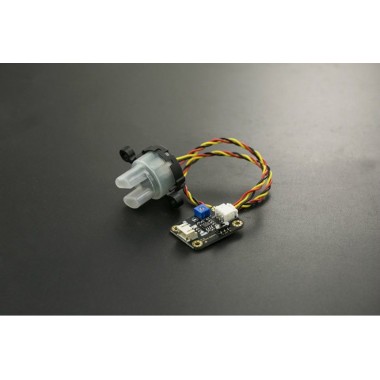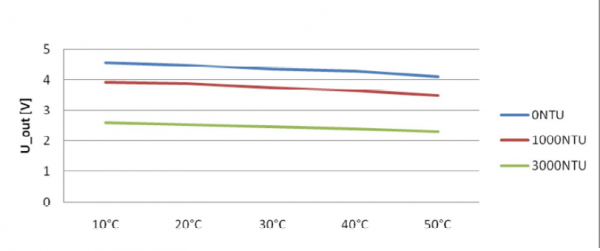Productos
Gravity: Analog Turbidity Sensor

Sensor de turbidez de de agua, con salidas analógica y digital.
COD: DFSEN0189
Peso: 0.030 Kg
Disponibilidad: Sin Stock
ARS 25925.00
El producto no está disponible para la venta en este momento
Características
This sensor have both analog and digital signal output modes. You can select the mode according to the MCU as threshold is adjustable in digital signal mode.
Turbidity sensors can be used in measurement of water quality in rivers and streams, wastewater and effluent measurements, sediment transport research and laboratory measurements.
Please note that the top of probe is not waterproof!
Specification
- Operating Voltage: 5V DC
- Operating Current: 40mA (MAX)
- Response Time : <500ms
- Insulation Resistance: 100M (Min)
- Output Method:
- Analog output: 0-4.5V
- Digital Output: High/Low level signal (you can adjust the threshold value by adjusting the potentiometer)
- Operating Temperature: 5℃~90℃
- Storage Temperature: -10℃~90℃
- Weight: 30g
- Adapter Dimensions: 38mm*28mm*10mm/1.5inches *1.1inches*0.4inches
DOCUMENTS
SHIPPING LIST
- Turbidity sensor adapter x1
- Turbidity sensor probe x1
- Turbidity sensor cable x1
- Gravity analog sensor cable x1
Connection Diagram
Interface Description:
- "D/A" Output Signal Switch
- "A": Analog Signal Output, the output value will decrease when in liquids with a high turbidity
- "D": Digital Signal Output, high and low levels, which can be adjusted by the threshold potentiometer
- Threshold Potentiometer: you can change the trigger condition by adjusting the threshold potentiometer in digital signal mode.
Examples
Here are two examples:
Example 1 uses Analog output mode
Example 2 uses Digital output mode
Example 1
void setup() {
Serial.begin(9600); //Baud rate: 9600
}
void loop() {
int sensorValue = analogRead(A0);// read the input on analog pin 0:
// Convert the analog reading (which goes from 0 - 1023) to a voltage (0 - 5V):
float voltage = sensorValue * (5.0 / 1024.0); Serial.println(voltage);
// print out the value you read: Delay(500); }
Example 2
int ledPin = 13; // Connect an LED on pin 13, or use the onboard one
int sensor_in = 2; // Connect turbidity sensor to Digital Pin 2
void setup(){
pinMode(ledPin, OUTPUT); // Set ledPin to output mode
pinMode(sensor_in, INPUT); //Set the turbidity sensor pin to input mode
}
void loop(){
if(digitalRead(sensor_in)==LOW){ //read sensor signal
digitalWrite(ledPin, HIGH); // if sensor is LOW, then turn on
}else{
digitalWrite(ledPin, LOW); // if sensor is HIGH, then turn off the led
}
}
This is a reference chart for the mapping from the output voltage to the NTU according to different temperature. e.g. If you leave the sensor in the pure water, that is NTU < 0.5, it should output “4.1±0.3V” when temperature is 10~50℃.
-
Note: In the diagram, the unit measuring turbidity is shown as NTU, also it is known as JTU (Jackson Turbidity Unit), 1JTU = 1NTU = 1 mg/L. Refer to Turbidity wikipedia









